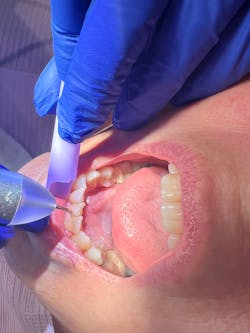Do you have a basic understanding of how a laser works? You can’t just unpack the laser, push a button, and swirl it around in a pocket. You might not realize the importance of laser physics; here's what it's all about.
So many times I hear, “We just want to know what settings to put the laser at.” Unfortunately, if we do that, the only thing that happens is that clinicians get discouraged when they aren’t getting the results they wanted, and patients aren’t happy because the laser “burned their gums.”
Read more about lasers in this series …
So, you want to be a laser dental hygienist?
Which dental laser should I choose, and what can I use it for?
What type of training do dental hygienists need to use lasers?
What is the difference between LAPT and LBR?
Laser safety eyewear: It’s nonnegotiable
How do you find the best laser for your dental practice?
Laser procedures for dental hygienists: Herpetic lesions and desensitization
You’ll be surprised by the questions your patients will ask you about the dental laser and how it operates. If you can’t answer those questions, your patients will be concerned about whether you really should be using a laser in their mouth.
So, what do we need to learn to understand all this?
What does LASER stand for?
Most people know the term laser, but do you know what it stands for?
L is for light
A is for amplification
S is for stimulated
E is for emission
R is for radiation
Light amplification by the stimulated emission of radiation.
But the easiest way to talk about lasers is to tell your patients that it’s light that is converted to heat.
Considerations about laser settings
When people learn about lasers, they’re often told to place the laser on a particular setting and begin lasering. However, it’s important to understand the chromophore of your patient’s tissue, so you can adjust the settings to stay within your scope of practice.
For instance, if you have someone with lighter skin tones, you may have to increase the laser settings to get the tissue to interact. If you have a patient with darker skin tones, you’ll need to turn the laser down to avoid cutting tissue. One of the chromophores that diode lasers are attracted to is dark pigmentation. If you have the laser setting too high, you’ll be out of your scope of practice, because you may be cutting tissue.
Keep in mind there are many things to consider when choosing a setting. Instead of just using a “suggested guideline” on a laser (which is a great way to help beginners choose a setting), you’ll want to take these things into consideration: power density + duration of exposure + amount of cooling + wavelength + emission mode + tissue characteristics = biological effect. These are known as laser tissue interaction and are the best things to consider when choosing a setting for a dental procedure.
Lasers also have different modes of operation: continuous wave or pulsed mode. Both modes have applications they can be used for, whether the operator is a hygienist or a dentist. The two tissue temperatures you’ll use the most for lasers are 60 degrees Celsius for coagulation and protein denaturation (for hygiene procedures), and 100 degrees Celsius (for vaporization and ablation during cutting procedures).
How do we know the temperature we’re approaching? Lasers don’t have a thermostat on them, so we must “read the tissue” to determine what’s taking place. For example, when using a laser in a periodontal pocket, you need to make sure you aren’t exceeding what you’re trying to accomplish. If you see the tissue starting to look “stringy” or having a white appearance, it could indicate that you’re starting to melt the tissue instead of decontaminating the area.
How to talk to patients about lasers
Verbiage about lasers is critical when explaining their use to patients. Avoid using words such as killing; that means we could be killing both good and bad bacteria, whereas the laser can be very specific and selectively target dark, pigmented bacteria. Avoiding talking about removing tissue; that procedure indicates cutting or ablating tissue. Instead, use words such as decontaminate, reduce, eliminate, which describe what hygienists are doing in a periodontal pocket.
Never guarantee what laser procedures can do. It’s OK to talk about what we expect the laser to do. For instance, telling patients that you’re removing herpetic lesions would be an incorrect statement. Don’t say that using the laser will cause the lesion to be gone forever. Instead, saying you have arrested the lesion is more accurate and will foster more realistic expectations. Don’t tell patients that their bone will grow back. Although we do see some changes in the bone, it depends on how well the patient maintains their oral health along with the laser procedures.
Laser physics is an important aspect of laser dentistry. Please take a laser course that helps you understand how and why lasers can do what they do. You’ll be glad you did.
Author’s note: The Academy of Laser Dentistry is a good resource.
Editor’s note: This article first appeared in Through the Loupes newsletter, a publication of the Endeavor Business Media Dental Group. Read more articles and subscribe to Through the Loupes.
About the Author
Angie Wallace, RDH
Angie Wallace, RDH, has been a clinical hygienist for more than 35 years. She is a member of the Academy of Laser Dentistry (ALD), where she obtained her advanced level proficiency, educator status, Recognized Course Provider status, and mastership. Angie is the chair for education on the ALD Board of Directors and serves on both the Regulatory Affairs and Auxiliary committees. She has a laser education consulting company, Laser Hygiene, LLC, and has been recognized as a worldwide speaker. Contact her at [email protected].


